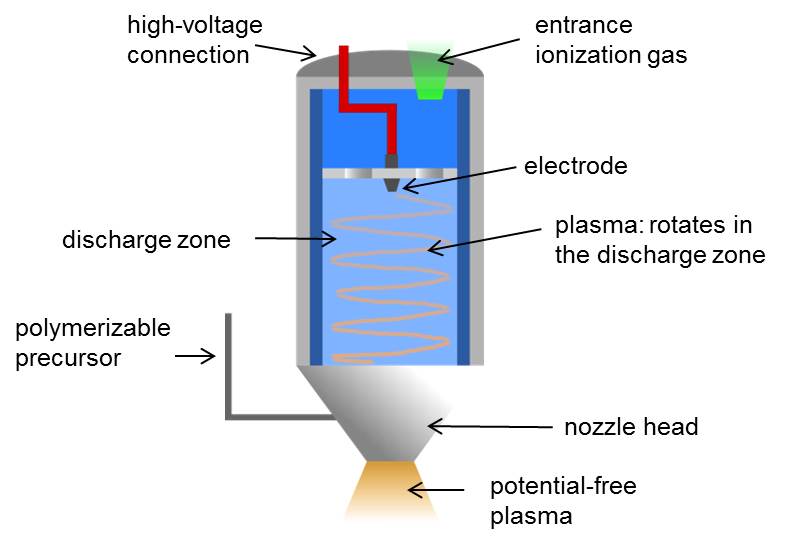Modification with atmospheric pressure plasma
 The use of atmospheric pressure plasma for surface treatment offers a wide range of uses. This technology is already being used in industrial applications. The elastomer surface (for example non-polar EPDM) is modified by plasma activation and polar functionalities (e.g. ester, amide or hydroxy functions) are generated on the surface, leading for a hydrophilization and an increase in surface energy. The rubber-rubber bonding can also be increased in the atmospheric pressure plasma (air plasma) with prior plasma treatment of the adhesive site (EPDM substrate, PUR adhesive). By means of so-called precursors, it is possible to carry out a plasma polymerization. By the use of selected organic molecules, plasma polymers can be selectively deposited on surfaces. These plasma polymers protect the surface and the material itself. Harmful substances such as ozone and salt water can no longer damage the material. Likewise, the friction coefficients of materials can be significantly reduced by the deposition of suitable plasma polymers.
The use of atmospheric pressure plasma for surface treatment offers a wide range of uses. This technology is already being used in industrial applications. The elastomer surface (for example non-polar EPDM) is modified by plasma activation and polar functionalities (e.g. ester, amide or hydroxy functions) are generated on the surface, leading for a hydrophilization and an increase in surface energy. The rubber-rubber bonding can also be increased in the atmospheric pressure plasma (air plasma) with prior plasma treatment of the adhesive site (EPDM substrate, PUR adhesive). By means of so-called precursors, it is possible to carry out a plasma polymerization. By the use of selected organic molecules, plasma polymers can be selectively deposited on surfaces. These plasma polymers protect the surface and the material itself. Harmful substances such as ozone and salt water can no longer damage the material. Likewise, the friction coefficients of materials can be significantly reduced by the deposition of suitable plasma polymers.
For the modification (plasma activation and plasma polymerization) of elastomer, plastic or metal surfaces, a plasma system from Plasmatreat is available at the DIK. The available atmospheric pressure plasma reactor operates with a plasma-jet.
In this process, the processing gas is passed through the plasma zone and then flows as an activated gas onto the substrate. The plasma itself is generated by an electric arc. It is essential that the plasma nozzle is grounded. The discharging processes at the outlet of the plasma remain in the interior of the nozzle and only the potential-free down-stream plasma radiates out in a beam-like manner. The beam length can be up to 30 mm depending on the nozzle used. This allows three-dimensional treatment and coating of substrates.
The activation and the cleaning of the surface are effected by the fragmented process gas, which enters the substrate surface. This step is for the pure activation and / or preparation of the polymerization step.
In the case of plasma polymerization, a defined flow rate precursor is transported via a pump into an evaporator and evaporated. The precursor is passed as a vapor into the plasma zone of the plasma nozzle with an additionally fed carrier gas (N2) and is fragmented due to high energy. The resulting molecular fragments are precipitated on the substrate surface after exit from the nozzle. They functionalize the substrate and form a permanent layer.
Contact person
